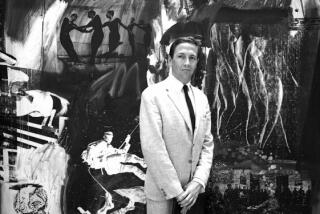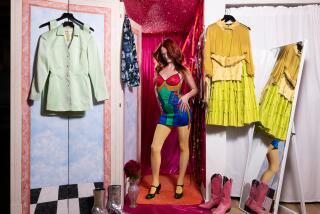BERNARDO, IS THAT YOU?
- Share via
LET’S face it, fashion isn’t usually about comfort, but for Bernard Rudofsky, nothing about modern clothing made sense. “Anachronistic, irrational, impractical and harmful,” he once declared.
Footwear was particularly perplexing to Rudofsky, a designer, architect and social critic who died in 1988 but took to questioning all aspects of modern life. In the late 1940s he struck back, not only by staging a series of controversial exhibits at the Museum of Modern Art that took aim at the unfriendliness of contemporary design, but also by creating a utilitarian sandal that would take the world by storm.
With interlacing straps, flat or wedged soles, and, most crucially, an effortless simplicity, the Bernardo sandal became the footwear of the ‘60s and ‘70s. A favorite of Jackie O. (who reportedly owned the Miami style in 16 colors), the Bernardo sandal was even spotted gracing the usually barefoot Joan Baez. They were the shoes you had to buy every year just as spring turned to summer.
Rudofsky developed his aesthetic as a graduate student studying architecture on the Greek isle of Santorini. Under the bright Mediterranean sun, he found his eye wandering from buildings and homes to feet. Inspired by classic strappy Greek sandals, he conceptualized a shoe with a sole that would mimic the shape of the foot.
In 1946, when he was already a noted architect, he established Bernardo Sandals, which, according to Harper’s Bazaar, were the first modern sandals. Vintage Bernardos are almost impossible to find these days (in most cases, the leather wore out eons ago). But the company was revived in 2002, and riffs on the legendary designs are sold in L.A. at Madison, American Rag Cie and Kitson.
To commemorate Rudofsky’s esoteric contributions to fashion and architecture, the Getty Museum is staging “Lessons From Bernard Rudofsky,” a small, tightly curated exhibit that includes Rudofsky’s architectural sketches and models, travel notebooks, photographs, a few pairs of original sandals and sculptures (he created a body form that would fit exactly into the silhouette created by a bustled Victorian-era dress; it’s a woman with four legs).
“We thought, ‘How is it possible that all of these different things came out of same mind?’ ” said Wim de Wit, curator for the exhibit. “He was the most consistent man I have ever seen. He goes back to the same things over and over again. He always knows he has more to say, and there’s always more to rethink.”
--
“Lessons From Bernard Rudofsky” at the Getty Museum, through June 8. Open 10 a.m. to 6 p.m. Tuesday through Sunday, 10 a.m. to 9 p.m. Friday and Saturday. 1200 Getty Center Drive, Los Angeles, (310) 440-7300. Admission is free, parking $8.
--






